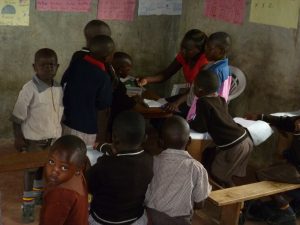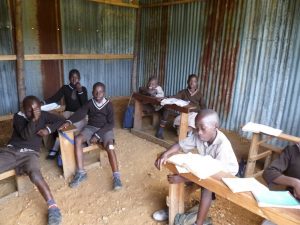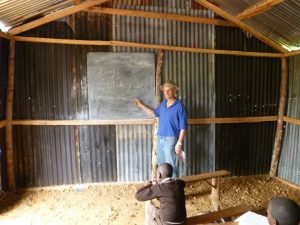
Pardon the sarcastic political reference in the title, but today was focused on the classroom experience which is certainly core to Achungo. I sat in on a number of the classes with the purpose of understanding what the teachers and the students are experiencing and what their potential needs are.
Appropriately enough, I started in the combined “Baby Class”/”Middle Class” – sat on the floor in the back and observed.These are all the pre-schoolers — 2 -5 year-olds.This is not babysitting or playtime – I’m impressed at the level of the classwork.In order to advance to Pre-Unit (Kindergarten), they must be able to count, know their letters, even sound out and write a few basic words.The little ones are coloring, and learning to match shapes, numbers and letters and are listening in as the older ones recite their numbers (counting) and letters.The older ones are writing simple words (‘cat’, ‘dog’).All of the training even in this class is in English, sometimes with explanations in Swahili or Luo (the local language).
The day starts with going over homework and Madam Nancy calls up each group to wait in line for her to correct their exercise books where she’s handwritten (yes, really!) the assignments for each of them the day prior.I’m amazed at how quietly the little ones sit as they wait though the process.
- (Is there anything I could do to help?)What if they had a way to copy off the exercise sheets?But how would they attach them to the exercise books?These little ones have a hard time keeping track of their one little exercise book and not returning to class with it torn up.Impressive enough that they have any homework!
- What if we got them coloring books? That would give them something to do during quiet times in class.
- Hmm. This class is covered with posters–almost all handmade (!). I wonder if we could find them some laminated posters with the same content.
After some time, I promote myself to Primary and sit in/ look in on the other classes.
- Kenya’s educational system has an 8-grade Primary (Kindergarten, called “Pre-unit” and then “Standards” 1 through 8). At the end of 8th grade is a national qualification exam that determines their next step. Place highly and you may get a government scholarship to Secondary (High School – called “Forms” 1 through 4). Otherwise, your academics may be over unless you can pay for a vocational school/college (typically 2 years of study).
- Government syllabus for the Standard grades includeSocial Studies, Math, Reading and Writing in English and Swahili, Science, and CRE (Christian Religious Ed – yes, as part of the government curriculum;there’s also a Moslem curriculum if your school has Moslems).
As I look in on the Pre-unit (Kindergarten), they are practicing simple arithmetic problems (addition, subtraction) and sentence completion.
In 1st Grade, as part of social studies, they are reciting and recording (in their exercise booklets) the “class rules”:
 Not to make noise in the classroom
Not to make noise in the classroom- To keep our classroom clean
- To ask for permission when you go out
- To obey our teachers and prefect
- To put up our hands before answering questions
- To take care of each other’s items
- To be in class in time
- To be neat and tidy
3rd Grade has fill-in-the-blanks in CRE
- Who was the father of Jesus?
- Joseph’s _________ sold him to Egypt
- Moses was given the _________ commandments on Mt Sinai
- Christians pray in _________ (mosque/churches)
In 4th Grade Science, Mr. Eliakim is quizzing the class on some physics basics:
- Which of the following floats and which will sink…a pin on a sheet of paper or a pin on its own?
- Next he describes an experiment to determine the effect of water depth on pressure (the behavior of water leaking through holes at various heights in the side of a tank). He holds the only textbook, so on the very rough blackboard he draws out its pictures of the example experiments as he describes them. [And I think: “that would be a lot easier if each child had a textbook to refer to”]
The African teaching style tends towards the Ferris Bueller’s Ben Stein-method of verbal “finish my sentence” (“…anyone? anyone?”) with either the entire class chiming in or the teacher asking “who can tell me” and students respond by raising their hands and clamoring to be called on (“teachah,teachah, teachah”). Much is rote style, especially in the earlier grades with the entire class reading the board together or reciting a poster or repeating after the teacher.
 Grades 3 and 4 gather for PE in a big circle around the trash pit (there’s no room elsewhere in the yard) and seem to be doing a “follow-my-moves” with first the teacher leading a variety of steps and motions and then one of the students. Looks like great fun. (And there may not be much else they can do in the current space and considering the entirety of their athletic equipment is one under-inflated, soccer ball and a few jump ropes.)
Grades 3 and 4 gather for PE in a big circle around the trash pit (there’s no room elsewhere in the yard) and seem to be doing a “follow-my-moves” with first the teacher leading a variety of steps and motions and then one of the students. Looks like great fun. (And there may not be much else they can do in the current space and considering the entirety of their athletic equipment is one under-inflated, soccer ball and a few jump ropes.)
Later that afternoon was my big debut! Mr. Richard let me teach Standard 4 (4th grade) a lesson in CRE. The government-issued (“Kenyatta Foundation”) course book contains simple Bible story lessons followed by key points and then a few fill-in questions. Our lesson was “Choosing to Belong” and it struck me how different the context might be in U.S. for the same lesson. I covered two stories — Adam and Eve punished for disobeying God, and the story of Abraham willing to obey and sacrifice his son if necessary, and how God honored them both as a result.
The main message was that we would be blessed if we always make the right choices and obey God and our teachers and our parents or guardians, and included a discussion of how to ask God for strength to find and follow the right choices. It occurs to me that in the U.S. that would be a lesson to individuals about individual choice, but here that context is merely an element of a greater value, that of belonging. Being in community as a value is well-understood here. Perhaps Western culture could benefit from thinking about our behaviors, our choices as impacting our connection with our community rather than limiting our view to ourselves as individuals.
The engagement of the children here is at a level unimaginable in the U.S. and towards the end of the school day I see that learning continues even after class. The preschoolers (“Baby Class” / “Middle Class”) sit outside as they wait for the closing assembly. They play quietly in the dirt with their hands or sticks (there’s nothing else to play with) until one starts reciting in English: “1, 2, 3…” and the whole crowd chimes in to recite their counting (“…108,109, 1000, 1001… 1008, 1009, one million”). (Yes, they skipped a few, but it’s a start!) Then they recite the colors (“cala red, cala blue…”), then the alphabet…and it strikes me that rote learning has given these children a number of very valuable tools:
- Their mind when idle will revert to what they’ve been repeating over and over, giving them effortless educational reinforcement.
- The classroom rote is a community-building activity.Learning is done together, it’s a shared process, one where you may depend on each other.As such it both reinforces the social value of education and the educational value of their social group (i.e., adds to how attentive they are, because this is something that is important to everyone).
It has certainly been a day of learning for me!
